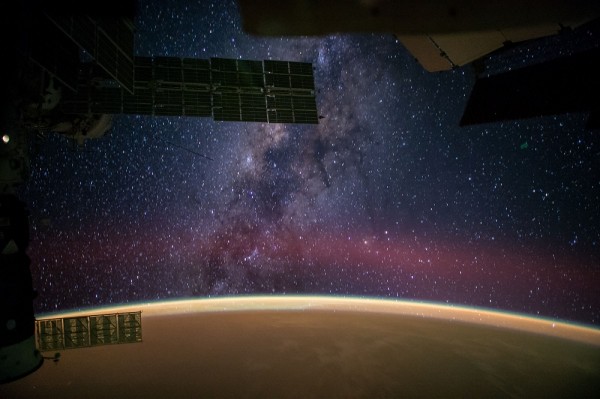How Much Does the Entire Milky Way Weigh? 700 Billion Suns
| Ana Verayo | | Jun 01, 2016 06:42 AM EDT |
(Photo : NASA/Reid Wiseman) NASA astronaut Reid Wiseman captured the Milky Way from the International Space Station.
Scientists now reveal how much the entire Milky Way galaxy weighs, which is an estimate of 700 billion solar masses, that has been the most accurate measurement yet by astronomers.
This latest estimate includes that mass of all stars and black holes in the galaxy including gas clouds and dust, and invisible dark matter along with other unidentified cosmic objects. The previous measurement was about a trillion solar masses, which has been a standard measurement for large astronomical objects.
Like Us on Facebook
One huge challenge to arrive at this current estimate is that astronomers should be able to precisely measure the speed of how many distant objects travelling within the Milky Way. However, this appears to be an impossible task as views from Earth only reveal a small fraction of the entire galaxy that is visible to ground telescopes.
According to lead author of the study, Gwendolyn Eadie from the McMaster University, the fact that we are inside this galaxy can truly produce some difficulties. She adds how here on Earth, we have a heliocentric perspective, as we see everything from the sun's position and its perspective, within our galaxy. The crucial factor here is to take the movement and the position of the sun into account while measuring the motions and positions of the rest of the objects in the Milky Way.
In this new study, Eadie and astronomer and physicist William Harris from McMaster University, consolidated the best incomplete data and produced a galactic mass estimator to achieve calculations that they claim to be the closest to any previous estimate by far.
Eadie says that the mass of the galaxy's dark matter halo is very crucial in the formation and evolution of the Milky Way. By knowing the mass of the galaxy, certain properties such as star formation rates and the growth size of supermassive black holes can be understood better, where new clues are revealed.
This understanding can lead to not only understanding our own galaxy but also putting the Milky Way in the context of other galaxies in the universe. With this new approach, this estimated total mass of the Milky Way at any distance within the galactic core can result in better and more accurate calculations for developing galaxy models. The galaxy is about 100 to 120 million light years in length.
Apart from this, the team can also use this total mass estimate of the galaxy to compute the amount of visible matter in the Milky Way and predict how much dark matter is inside, as dark matter makes up about 88 percent of the galactic mass.
These new findings are presented at the annual conference of the Canadian Astronomical Society.
Tagsmilky way galaxy, how much does milky way weigh, Galaxy, mass of milky way, Black Holes, Stars
©2015 Chinatopix All rights reserved. Do not reproduce without permission
EDITOR'S PICKS
-

Did the Trump administration just announce plans for a trade war with ‘hostile’ China and Russia?
-

US Senate passes Taiwan travel bill slammed by China
-

As Yan Sihong’s family grieves, here are other Chinese students who went missing abroad. Some have never been found
-

Beijing blasts Western critics who ‘smear China’ with the term sharp power
-

China Envoy Seeks to Defuse Tensions With U.S. as a Trade War Brews
-

Singapore's Deputy PM Provides Bitcoin Vote of Confidence Amid China's Blanket Bans
-

China warns investors over risks in overseas virtual currency trading
-

Chinese government most trustworthy: survey
-

Kashima Antlers On Course For Back-To-Back Titles
MOST POPULAR
LATEST NEWS
Zhou Yongkang: China's Former Security Chief Sentenced to Life in Prison

China's former Chief of the Ministry of Public Security, Zhou Yongkang, has been given a life sentence after he was found guilty of abusing his office, bribery and deliberately ... Full Article
TRENDING STORY

China Pork Prices Expected to Stabilize As The Supplies Recover

Elephone P9000 Smartphone is now on Sale on Amazon India

There's a Big Chance Cliffhangers Won't Still Be Resolved When Grey's Anatomy Season 13 Returns

Supreme Court Ruled on Samsung vs Apple Dispute for Patent Infringement

Microsoft Surface Pro 5 Rumors and Release Date: What is the Latest?










